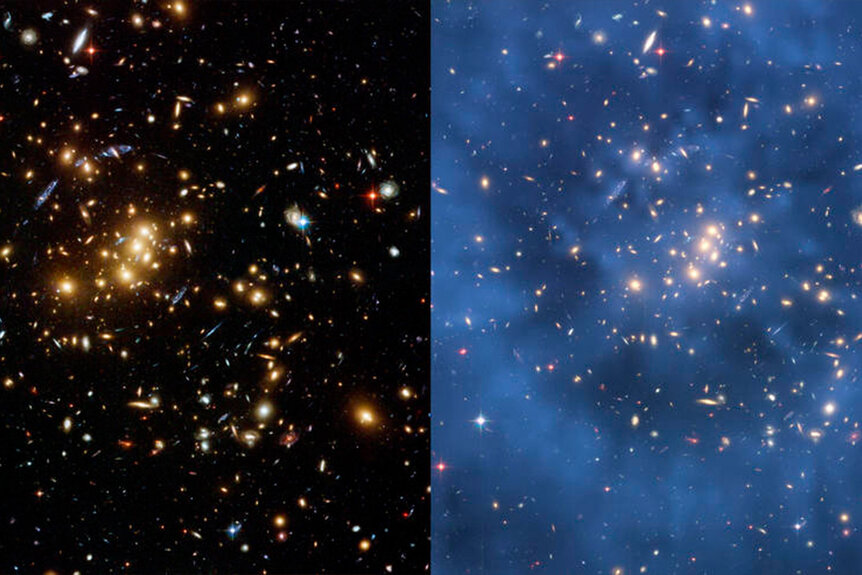Create a free profile to get unlimited access to exclusive videos, sweepstakes, and more!
Dark matter may have come from a second, darker Big Bang
They were, all of them, deceived, for another Big Bang was made.

Star Trek or Star Wars? It’s an age-old debate which has forged and destroyed friendships over the last half-century, but it is incomplete. The debate over Trek or Wars relies on a false dichotomy which ignores the existence of Battlestar Galactica, Firefly, and Farscape, just to name a few. In fact, Farscape (now streaming on Peacock!) managed to mash together the things that made both Star Wars and Star Trek so much fun, all in a single story.
The series was a joint Australian-American endeavor produced by the Jim Henson Company, who also lent their talents to make-up, prosthetics, and animatronic puppet characters. The series premiered on SYFY (then the Sci-Fi Channel) in March of 1999 and ran for four seasons, as well as a miniseries called The Peacekeeper Wars (also on Peacock), which wrapped up a few loose ends. The series follows a diverse crew on the run from a militaristic authority aboard a living cyborg spacecraft. In the hope of winning the war once and for all, they pursue new weapons technologies powered by wormholes.
RELATED: Hop aboard Moya with all 4 seasons of ‘Farscape’ & ‘Peacekeeper Wars’ now streaming on Peacock
It isn’t the first time we have imagined incredible powers waiting to be tapped in the vastness of space, and it won’t be the last. Wormholes might exist, and they might not. They are supported by the math of Einstein’s general theory of relativity, but we have yet to find one in the wild. Still, if we’re looking for mysterious forces with the potential to rewrite our understanding of the universe and our place in it, we need look no further than dark matter.
In recent years, the scientific community and the public has become increasingly interested in the dark counterparts of our own universe. When we think of the cosmos, we think mostly of stars and planets, galaxies, nebulae, black holes… you know, matter. In truth, however, the vast majority of the stuff in the universe isn’t matter at all. According to our best models, only about 5% of everything in the universe is ordinary matter. A further 24% of the universe is made up of dark matter, and the remainder, nearly three quarters of all stuff, is dark energy. There’s still a lot we don’t know.
Dark matter takes its name from the fact that, no matter how hard we try, we can’t seem to see it. We know it’s there, thanks to the gravitational interactions we observe as we look at objects in space, but that’s it. It’s the physical equivalent of the feeling that there is someone standing next to you in a pitch black room. You can feel them there, even if you can’t see them. That’s sort of how dark matter behaves.
Imagine yourself sitting on a trampoline while wearing a blindfold. Suddenly, something or someone joins you on the trampoline. You can’t see what it is, you don’t hear any noises, but you feel the unmistakable sensation of the springs and fabric reacting to a new presence. You know something is there from the way it distorts the fabric, pulling you toward it. That’s more or less the relationship we have with dark matter. There’s something on the cosmic trampoline with us, but we don’t know what it is or where it came from.
Now, Katherine Freese and Marting Wolfgang Winkler, both researchers from the University of Texas at Austin, have proposed a new explanation for the origin of dark matter in a study posted to the arXiv preprint server.
Something like 14 billion years ago, give or take a few hundred million years, the universe burst into being in an incredible and unimaginable explosion known as the Big Bang. What was before an infinitely small singularity of unimaginably dense material, let out its breath in a staggering exhalation, and the universe was born. Within a fraction of a second the fundamental forces were established and the universe underwent a burst of rapid expansion. Three minutes later the first protons, neutrons, electrons, and neutrinos had formed and normal matter, mostly hydrogen and helium, began to appear through a process known as Big Bang nucleosynthesis (BBN). Then things slowed down a bit, the hot and packed plasma which comprised the entirety of the universe continued to cool. More and more atoms emerged from the morass and organized themselves into the first stars, planets, and galaxies.
That’s the current picture of the early universe and it has served us pretty well, but that doesn’t mean we can’t improve upon it. According to the study, if dark matter was also created during the Big Bang, we should expect to see a greater level of interaction between dark matter and ordinary matter. Instead, dark matter appears to interact only gravitationally with ordinary matter. Moreover, there is no evidence that dark matter existed during the earliest stages of the universe.
RELATED: Watch as a million galaxies form in the first billion years of the cosmos
To solve both of those issues, researchers propose a second Dark Big Bang occurring roughly a month after the Big Bang you’re familiar with. They suggest that the first Big Bang could have created a large amount of dark plasma which eventually became dark particles and dark matter, in much the same way that ordinary matter did. The creation of dark matter a month after ordinary matter could explain both why we don’t see it in the early stages of cosmic development and why dark matter doesn’t interact all that much with ordinary matter. It could also open up new opportunities for studying dark matter with existing and emerging tools.
According to the study authors, ongoing pulsar timing experiments could be capable of detecting gravitational waves generated by the proposed Dark Big Bang. In fact, they may already have captured a signal from the event. Researchers are careful to note that more research is needed and future observations could rule out their proposal, but it could also be confirmed and help us to finally unravel one of the universe’s weirdest mysteries.
See dark matters of another kind on Farscape, streaming now on Peacock!



























